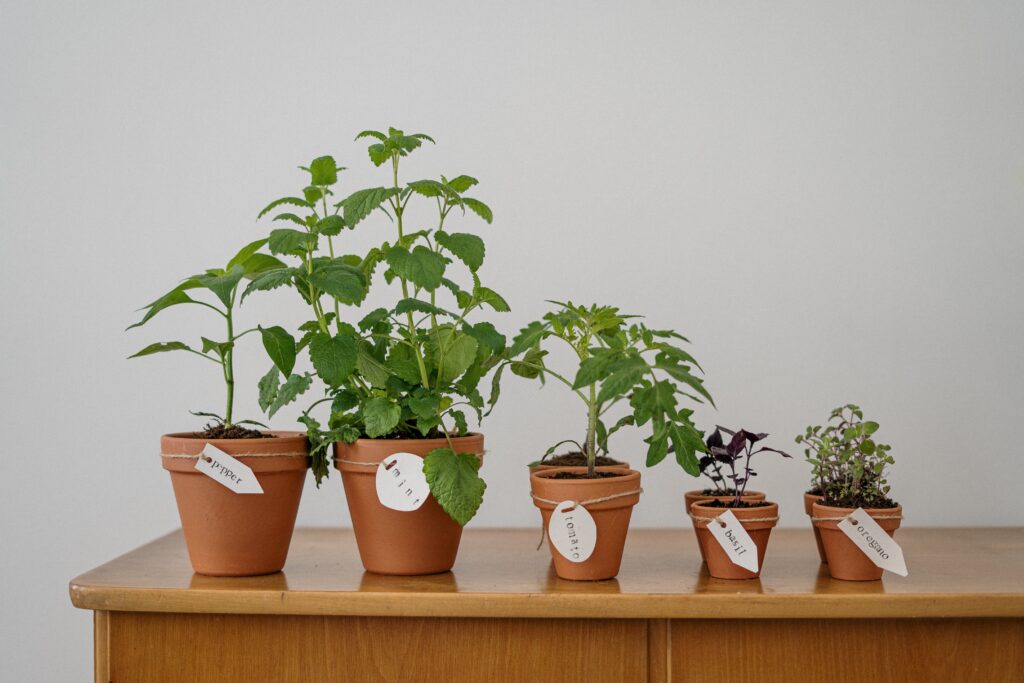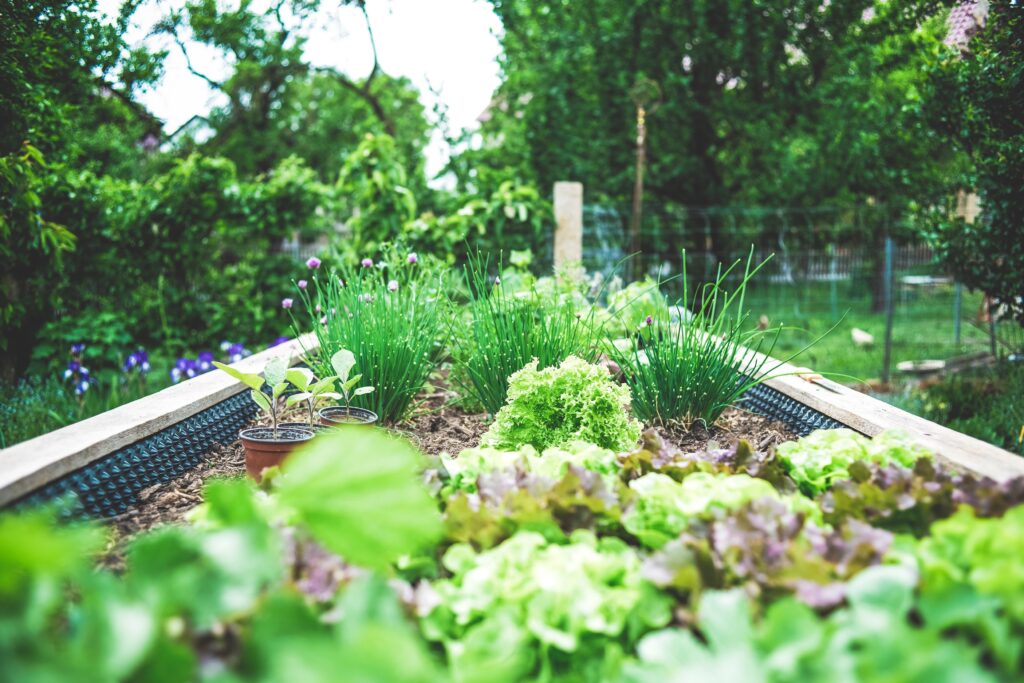Are you still on the fence about starting a vegetable garden? You know it is valuable, but maybe it just seems like a lot of hard work. Come along with me as I guide you from start to finish as you learn how to create a vegetable garden of your own. Becoming a gardener is so rewarding and this is your year!
Why should you learn how to create a vegetable garden?
Growing food is very rewarding.
When you grow food for yourself or your family, you receive a reward that is hard to put into words. Even after many successful seasons as a gardener, it never gets old when you can finally harvest your first pot of green beans for supper. When your table is dotted with garden contributions from you own hands, it’s invigorating!
Lastly, no matter what happens, you will need to eat tomorrow. Your family will wake up and need food. It is incredibly reassuring to know that your garden can provide that sustenance no matter what life throws your way. Sow a garden, grow resilience.

Seeing plants thrive is very satisfying.
While I don’t want to romanticize vegetable gardening to the point of being ridiculous, I do want to remind you of the child-like wonder I experienced back in elementary school. Seeing that hard bean coating break apart, and the green sprout begin to unfold and stretch for the sky a little more each day, was so satisfying. So satisfying, in fact, that I still get giddy each year once seed-starting begins. I hurry to my greenhouse, peer down on the seedling trays and sometimes shout, “Hallelujah!” This response is usually reserved for my absolute favorite Hillbilly Tomato.
Up until now, maybe you have had some gardening success in pots. It is time to branch out. Take the leap and plant an actual garden filled with the varieties you have already succeeded in growing. It is not enough to learn how to create a vegetable garden, you must get those fingers dirty and do it!
Remove from your mind any excuses that are keeping you from growing, pun intended. If you only have a concrete patio, build some beds and bring in the soil. If your grade is too steep, get some help and terrace the space to grow. Remove some trees, smother the lawn, whatever it takes, let’s get growing!
Fresh is best.
Do I need to say more? No, but I will. Many people think they don’t like certain vegetables when in reality, they just don’t like stale, lifeless, mass-produced vegetables. When given the opportunity to sample the “same” vegetable from a home garden, their eyes light up, their mouth curves into a smile, and they are smitten. Properly prepared, fresh, local produce is far superior in taste and nutrition to anything commonly available in grocery stores. Sharing this news with others really has me feeling like a Brussels sprout Evangelist. Amen!
It is probably good to note that when you grow your own vegetables, you have complete control over how they are grown. From the development of soil life that will serve as your plant’s nutrition source, to the weed and pest control methods used, you will know exactly what you are consuming.

Opportunities to share.
In all likelihood, even if this is the first year you learn to grow a vegetable garden, you will have a harvest of some sort. It is also likely, based on the laws of sowing and reaping, that you will get far more than you planted. Some specific plants (I’m looking at you, Okra) are more prone to over-producing than others. While I sometimes feel a little stingy with my precious tomatoes, I am always willing to share my garden excess with others. You also will find yourself giving away squash, garlic and peppers before you know it!
Cost analysis.
There will be some up-front costs when you start your garden. You will need to purchase seeds or plant starts, soil, fertilizer, and whatever materials you choose to use when making the garden itself. Over time, these purchases will cost you less and less as you continue to grow and harvest more vegetables from your initial investment. The up-front costs can also be as great or small as you want them to be. Don’t invest in raised beds if you cannot afford them this year.
As a gardener, you will soon learn that the health benefits you receive from your garden far outweigh the cost of entry. Many understand the nutrition boost and increased physical strength they gain by gardening, but the mental health aspect is often overlooked. It is remarkable to learn how our bodies were designed to respond favorably to the simple act of getting our hands in the soil. Time spent in the garden is time spent releasing stress and relieving anxiety. This health benefit alone is invaluable!

When should you create a vegetable garden?
Yesterday. Seriously, unless yesterday was Thanksgiving Day, you should have already planted your vegetable garden. Here in the Deep South, we can garden outdoors all year. This is a fact I am much appreciative of as a gardener. If that is not the case for you, there is still probably quite a bit you can do to get started with your gardening efforts, unless you live where there are literal feet of snow on the ground currently.
Seasonal considerations.
I want you to think about the duration and severity of your seasons before you begin putting plants in the ground willy-nilly. What are the other gardeners around you, if any, planting right now? If they are harvesting peas, it’s likely not time to be planting peas, as that has passed. You might look up your USDA hardiness zone, but that has little to do with your gardening efforts and has much more bearing on the perennial plants and trees you want to grow.
Vegetable crops are usually classified by their suitability for planting according to the seasons. For example, there are spring crops, summer, crops, and fall crops in most regions. For instance, you would not start watermelon seeds in July unless you know you have enough frost-free days left in your gardening window. Most seed packets provide the number of “days until harvest” on the back of the envelope.
Once you are armed with the knowledge of how many days it will take to grow whatever vegetable you have chosen, you will want to determine your “first frost date.” Your first frost date is an average calculation of the dates when your area has received its first killing frost. This date is an estimation and not a concrete certainty.
On the other end of the spectrum is the average last frost date. This date is a calculation of when it is generally considered safe to put your plants outdoors, barring any local weather anomaly. This is a great time to make new gardening friends and ask them what they have observed to be the realistic date for your area.

Where should you create a vegetable garden?
Practical considerations.
You will want to put your garden in whatever space you have available to you. Visualizing where your garden space will be is helpful to you when deciding what and how much you can grow. Maybe you have an unsightly view that a luscious wall of climbing tomato vines and pole beans would be the perfect solution for.
Most importantly, make sure you situate your garden in a place where you frequently visit. Perhaps along your driveway so you will see it each time you leave and return home. It will be much easier for you to tend and care for your garden if you are careful to put it in a place that you easily notice and will not neglect. Out of sight, out of mind.`
Lastly, no matter how large or how lovely your garden space is, it will never produce abundantly for you if it does not receive adequate sunlight. Placing your garden in a place that provides your plants with 6–8 hours of direct sun is best, if not an absolute requirement. While it may be nice for you to garden under the canopy of shade from the nearby trees, your vegetable plants do not agree. Without sufficient sun exposure, they will not thrive.

How should you create a vegetable garden?
Variety consideration.
As you begin to create your garden, you should give careful consideration to what you will grow. If you do not like a certain food, do not grow it your first season. This endeavor is going to take considerable effort on your part. Do not waste that effort growing food you will not eat. On the other hand, if you are in the produce department and have the thought, “Hey, I could grow that.” Make a list of those vegetables and start your garden with that list.
Budget consideration.
If your construction budget is zero, a good way to prepare a site for vegetable production is called sheet mulching. The most effective way is to layer free cardboard on the ground 4 to 8 inches thick. Water well. Cover that layer thickly with mulch. This can be as simple as leaves, grass clippings, shredded wood chips, hay or straw. Water again. When you are ready to plant, pierce holes through the cardboard into the grand, place your plant in the hole, re-cover with the mulch.
If you also short on time, it is perfectly acceptable to till up your garden area. Find a local gardening friend and borrow their tiller. Many hardware stores also rent tillers. Be diligent to maintain the borders throughout the season or the lawn will overtake your new garden.
If you have a little more time and money to spend on materials, look at the concrete block and 2×6 option. These materials are readily available at the local home stores, are easy to transport, and easy to assemble. If you are really serious about spending some time and money on your new vegetable garden, corrugated metal and 4×4 posts are a lovely and long-lasting option. You can see inspiring examples of all of these construction styles in use, as well as some container growing using tractor tires in this video.

Even if your first-year garden does not turn out as you hope, it will certainly be better than growing no garden at all. Expect that some vegetable varieties will produce better some years than they do the next. This is usually due to nothing that you as a gardener have control over. Just knowing this fact prepares you to be a more confident gardener.
Congratulation, you’re a gardener! If you have any questions about what I have said here, drop them in the comments below. If you have some great gardening inspiration to share, please let us hear it in the comments as well.


